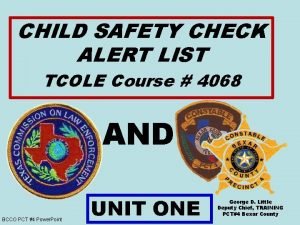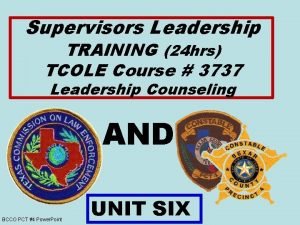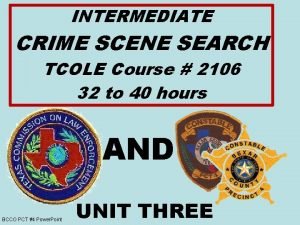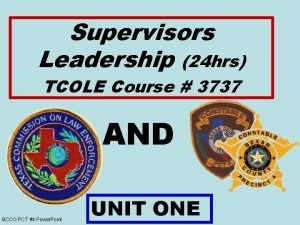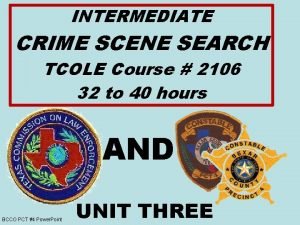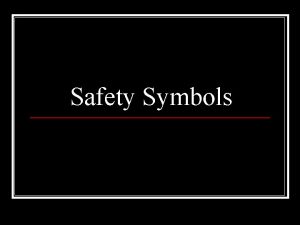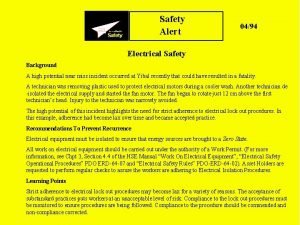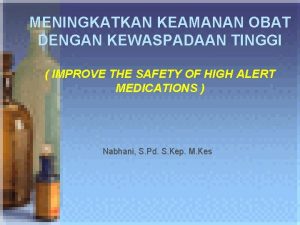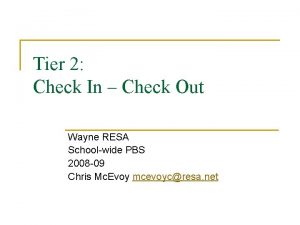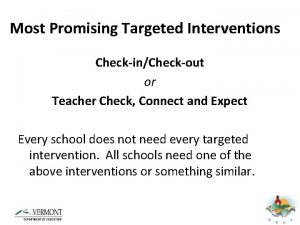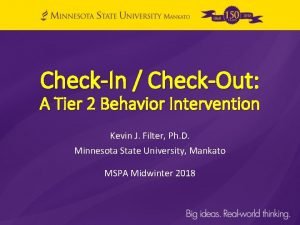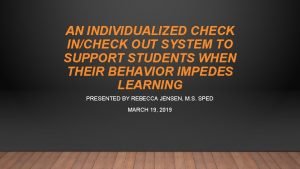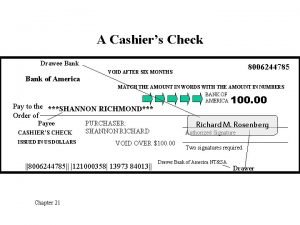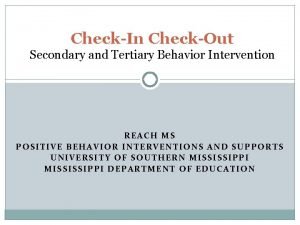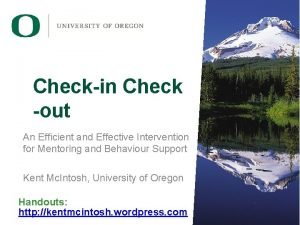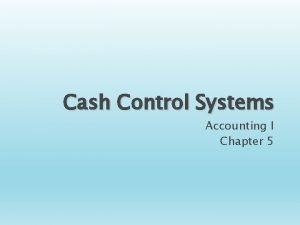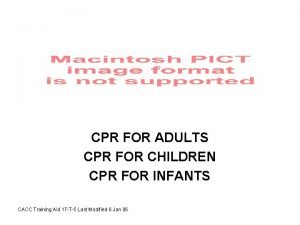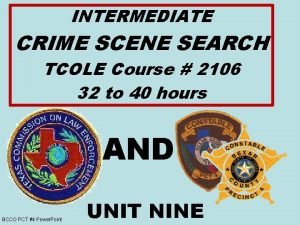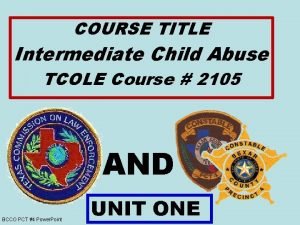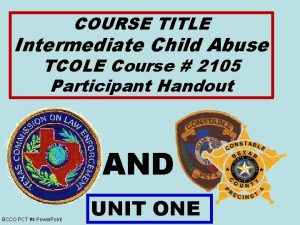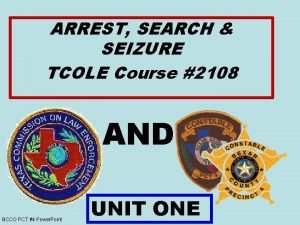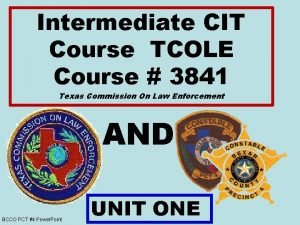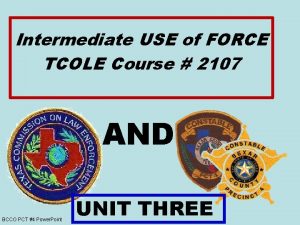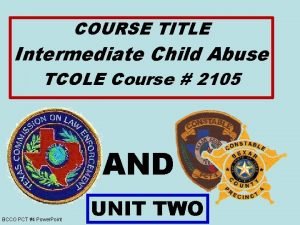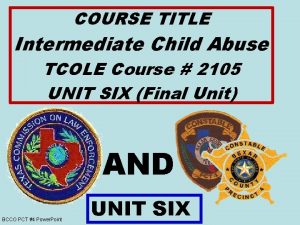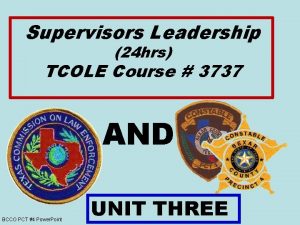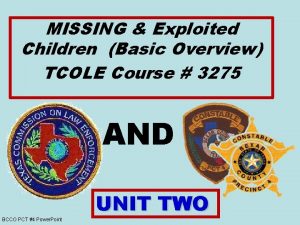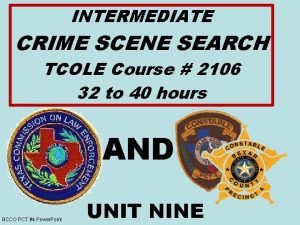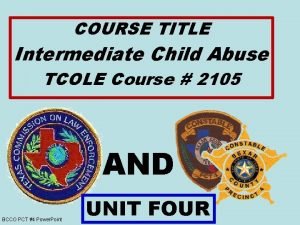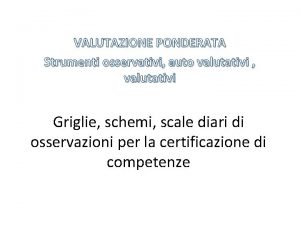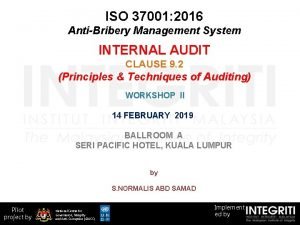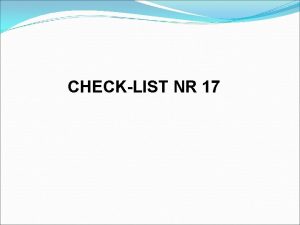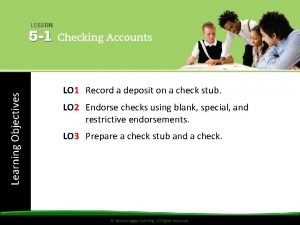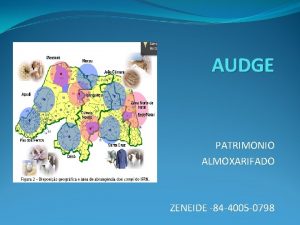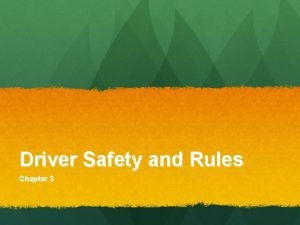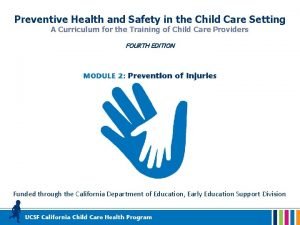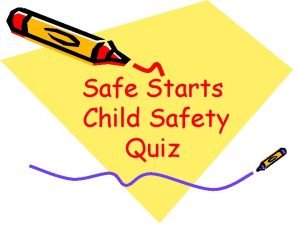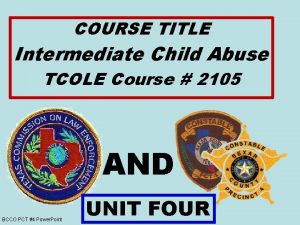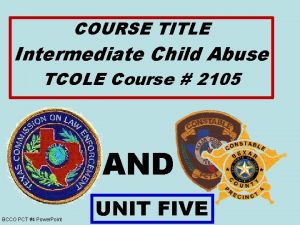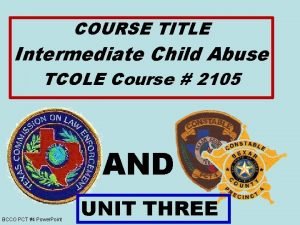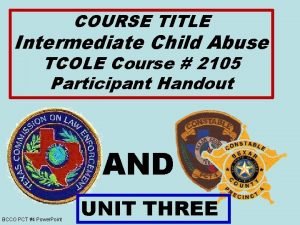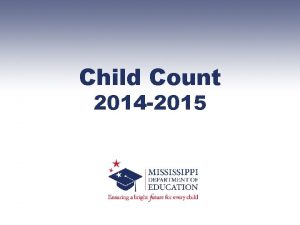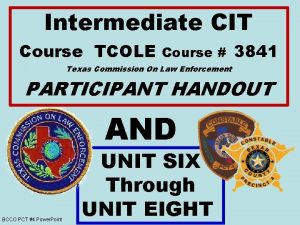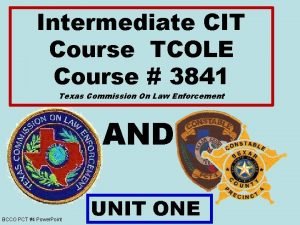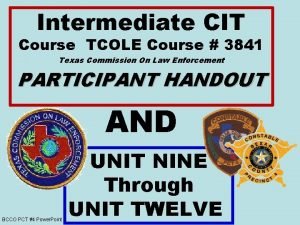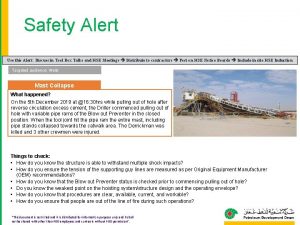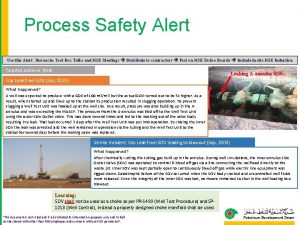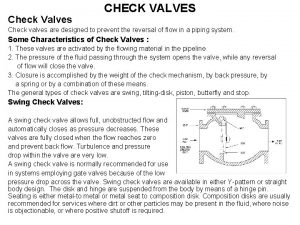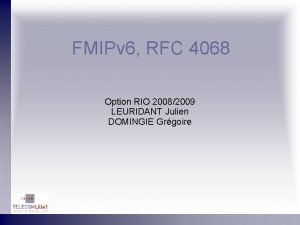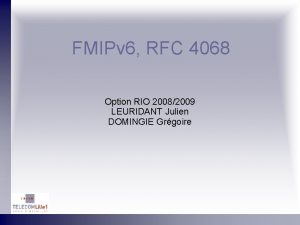CHILD SAFETY CHECK ALERT LIST TCOLE Course 4068































































- Slides: 63

CHILD SAFETY CHECK ALERT LIST TCOLE Course # 4068 AND BCCO PCT #4 Power. Point UNIT ONE George D. Little Deputy Chief, TRAINING PCT#4 Bexar County

WELCOME This course/lesson was directed by Constable Robert M. (Mike) BLOUNT. It is essential for all of my Deputy Constables to know how to better keep our children safe as well as protocols for conducting child abuse investigations and/or referral to Child Protective Services. It is imperative that all Deputy Constable’s assigned to our Agency become familiar with our NEW Standard Operating POLICY & PROCEDURES (SOP&P) that coincide with this course. .

ADMINISTRATIVE • Please complete the BCCO PCT #4 Registration form and turn it in now. • Make sure you sign TCOLE Report of Training (PID#, Full Name and DOB). • All cell phones off please – pay attention to course materials and show common respect & courtesy.

Your Instructor – Course Facilitator and Mentor Trainer Deputy Chief George D. Little A. S. & B. S. Criminal Justice & Sociology B. S. CJ Wayland Baptist University, San Antonio M. S. Criminology & Counter-Terrorism University of the State of New York(P) 2012 T. C. O. L. E. Professional Achievement Award Certified Crime Prevention Specialist (C. C. P. S. ) FAMS TCOLE Basic Instructor Certificate 1984 CERTIFIED TCOLE Advanced Instructor 2012 INSTRUCTOR TCOLE Master Peace Officer 1991 MP Special Operations Operator Counter-Terrorism 1988 Military Police Investigations (MPI) & Criminal Investigation Division (CID) Special Agent Graduate Drug Enforcement Administration Academy 1977 44 - years Law Enforcement Experience 11/25/2020 40 -Years Teaching & Instructor Experience 4

COURSE/LESSON OVERVIEW According

FORWARD • Each year,

UNIT ONE 1. 0 Unit Goal: The Child Safety Check Alert List law (CSCAL) has existed since 2005. All peace officers should be familiar with the CSCAL and the purpose of the list.

Learning Objectives Learning Objective 1. 1: Participant will be able to discuss the purpose of the list. Learning Objective 1. 2 : Participant will be able to provide some differences between a missing person report and CSCAL. Learning Objective 1. 3 : Participant will be able to discuss the update to Family Code § 261. 301 Investigation of Report.

1. 1 Purpose of the Child Safety Check Alert List (CSCAL) What is the CSCAL: The Child Safety Check Alert List (CSCAL) is a method for Child Protective Services to report the names of children and their legal guardians who they are attempting to locate for the purpose of……. .

1. 1 Purpose of the Child Safety Check Alert List (CSCAL) – Cont’d What is the CSCAL – Cont’d: investigating allegations or providing services. This report is submitted to the Texas Crime Information Center by the Child Protective Services (CPS) division of the Texas Department of Family Protective Services.

1. 1 Purpose of the Child Safety Check Alert List (CSCAL) – Cont’d The Purpose of the CSCAL is for CPS to locate a child and the legal guardian(s) to: üInvestigate a report of child abuse or neglect or üProvide protective services to a family receiving family-based safety services, which can include family preservation services.

1. 2 What are some differences between a missing person report and CSCAL üThe child is with a legal guardian(s) üIs only entered into TCIC (Texas only) üRemains in the TCIC for twelve months

1. 2 What are some differences between a missing person report and CSCAL – Cont’d Missing Person üThe legal guardian does not know the location of the child üThe legal guardian can be the Department of Family and Protective Services, to include conservatorship of the child

1. 2 What are some differences between a missing person report and CSCAL – Cont’d Missing Person – Cont’d üIs entered into NCIC üRemains in the system indefinitely until located

1. 3 Up-date to Texas Family Code § 261. 301 of the Family Code provide guidelines for how and when DFPS and law enforcement should investigate jointly a report of abuse/neglect of a child. HB 2053 added a new subsection to explain requirements to investigate and respond to CSCAL related allegations.

1. 3 Up-date to Texas Family Code § 261. 301 – Cont’d The new section reads as follows: (i) If at any time during an investigation of a report of child abuse or neglect to which the department has assigned the highest priority the department (Department of Family and Protective Services) is unable to locate the child who is the subject of the report of abuse

1. 3 Up-date to Texas Family Code § 261. 301 – Cont’d The new section reads as follows: • (Cont’d) or neglect or the child's family, the department shall notify the Department of Public Safety that the location of the child and the child's family is unknown.

1. 3 Up-date to Texas Family Code § 261. 301 – Cont’d The new section reads as follows (Cont’d) If the Department of Public Safety locates the child and the child's family, the Department of Public Safety shall notify the department of the location of the child and the child's family.

DEFINE & PROCESS Explain 1. 1: What CSCAL is and what is its 1. 1: purpose Process: 19

DEFINE & PROCESS 1. 2 Explain: Differences between CSCAL and Missing Person. Process: 20

DEFINE & PROCESS Explain 1. 3: Latest up-date to the Family Code 1. 3: § 261. 301 Investigation of Report. Process: 21

QUESTIONS

UNIT TWO 2. 0 Unit Goal: Encounters with persons listed on the Child Safety Check Alert List.

Learning Objectives Learning Objective 2. 1 : Participant will be able to list steps they must perform upon encountering a person listed on the CSCAL. Learning Objective 2. 2 : Participant will be able to describe the authority law enforcement has to temporarily detain a child and child’s family for the purposes of assessing the well-being of that child. Learning Objective 2. 3 : Participant will be able to describe proper placement and release of a child.

2. 0 Unit Goal: Encounters with persons listed on the Child Safety Check Alert List. There are various conclusions that can occur when an officer encounters someone listed on the CSCAL. 1. An officer may need to take temporary possession of the child due to reasons unrelated to CSCAL.

There are various conclusions that can occur when an officer encounters someone listed on the CSCAL. – Cont’d: üAn officer may need to release the child to the Department of Protective and Family Services – CPS. üAn officer may need to release the child back to the custody of the legal guardian.

2. 1 List steps must perform upon encountering a person listed on the CSCAL. 1. Immediately contact the Department of Family and Protective Services on the department’s dedicated lawenforcement telephone number for statewide intake.

2. 1 List steps must perform upon encountering a person listed on the CSCAL – Cont’d. 2. Request information from the department regarding the circumstances of the case involving the child or other person.

2. 1 List steps must perform upon encountering a person listed on the CSCAL – Cont’d. 3. Request information from the child and the other person regarding the child’s safety, wellbeing and current residence.

2. 2 Describe the authority LE has to temporarily detain a child and child’s family Describe the authority law enforcement has to temporarily detain a child and child’s family for the purposes of assessing the well-being of that child. üBeing observant of all persons in the vicinity of a law enforcement encounter should be exercised by officers at all times.

2. 2 Describe the authority LE has to temporarily detain a child and child’s family – Cont’d: Describe the authority law enforcement has to temporarily detain a child and child’s family for the purposes of assessing the wellbeing of that child – Cont’d: üThis includes remaining alert for children and assessing the immediate safety and well-being of that child.

2. 2 Describe the authority LE has to temporarily detain a child and child’s family – Cont’d: Describe the authority law enforcement has to temporarily detain a child and child’s family for the purposes of assessing the well-being of that child – Cont’d: üThere are different statutes which authorize law enforcement officers to take certain action to ensure a child’s safety and well-being before releasing that child.

2. 2 Describe the authority LE has to temporarily detain a child and child’s family – Cont’d: Section 2. 72 of the Code of Criminal Procedure provides the specific authority an officer has as it relates to the Child Safety Check Alert List. (b) the peace officer may temporarily detain the child or other person to ensure the safety and well-being of the child.

2. 2. 1 Once an officer notifies the DFPS The CPS Case Worker will make the decision whether to respond to the location of the officer and child or person of interest. Regardless of the response by CPS, the officer should assess the immediate safety and well-being of the child.

2. 2. 1 Once an officer notifies the DFPS - Cont’d: Existing statute under Family Code § 262. 104 allows an officer to take temporary possession of the child without a court order if certain circumstances exist. The conditions of Family Code § 262. 104 that permit law enforcement to take temporary possession are:

2. 2. 1 Once an officer notifies the DFPS - Cont’d: The conditions of Family Code § 262. 104 that permit LE to take temporary possession are: (1) on personal knowledge of facts that would lead a person of ordinary prudence and caution to believe that there is an immediate danger to the physical health or safety of the child;

2. 2. 1 Once an officer notifies the DFPS Cont’d: The conditions of Family Code § 262. 104 that permit LE to take temporary possession are – Cont’d: (2) on information furnished by another that has been corroborated by personal knowledge of facts and all of which taken together would lead a person of ordinary prudence and caution to believe that there is an immediate danger to the physical health or safety of the child;

2. 2. 1 Once an officer notifies the DFPS - Cont’d: The conditions of Family Code § 262. 104 that permit LE to take temporary possession are – Cont’d: (3) on personal knowledge of facts that would lead a person of ordinary prudence and caution to believe that the child has been the victim of sexual abuse;

2. 2. 1 Once an officer notifies the DFPS Cont’d: The conditions of Family Code § 262. 104 that permit LE to take temporary possession are – Cont’d: (4) on information furnished by another that has been corroborated by personal knowledge of facts and all of which taken together would lead a person of ordinary prudence and caution to believe that the child has been the victim of sexual abuse;

2. 2. 1 Once an officer notifies the DFPS Cont’d: The conditions of Family Code § 262. 104 that permit LE to take temporary possession are – Cont’d: (5) on information furnished by another that has been corroborated by personal knowledge of facts and all of which taken together would lead a person of ordinary prudence and caution to believe that the parent or person who has

2. 2. 1 Once an officer notifies the DFPS - Cont’d: The conditions of Family Code § 262. 104 that permit LE to take temporary possession are – Cont’d: (5) – Cont’d: possession of the child is currently using a controlled substance as defined by Chapter 481, Health and Safety Code, and the use constitutes an immediate danger to the physical health or safety of the child

2. 2 Proper placement and release of a child. If an officer takes temporary possession of a child solely based on the conditions and authority of Family Code 262. 104, then that officer may only release that child to certain authorized persons.

2. 2 Proper placement and release of a child – Cont’d According to Family Code 262. 1041, when an officer takes temporary possession of a child under the conditions of Family Code 262. 104, that officer may only release to: (1) a child-placing agency licensed by the Department of Family and Protective Services under Chapter

2. 2 Proper placement and release of a child – Cont’d Family Code 262. 104, that officer may only release to: (1)- Cont’d: 42, Human Resources Code, if the agency is authorized by the department to take possession of the child;

2. 2 Proper placement and release of a child – Cont’d Family Code 262. 104, that officer may only release to: (2) the Department of Family and Protective Services; or (3) any other person authorized by law to take possession of the child.

QUESTIONS

DEFINE & PROCESS Explain 2. 1: List steps you must follow/perform 2. 1: upon encountering a person listed on CSCAL Process: 47

DEFINE & PROCESS Explain 2. 2: Describe the authority you as a 2. 2: Law Enforcement Officer have to temporary detain child and child’s family ref: well-being Process: 48

DEFINE & PROCESS Explain 2. 2. 1: What are conditions under 2. 2. 1: Family Code § 262. 104 that permit law enforcement to take temporary possession. Process: 49

DEFINE & PROCESS Explain 2. 3: Describe proper placement and 2. 3: release of a child Process: 50

UNIT THREE 3. 0 UNIT GOAL: When an officer encounters a child or person listed on the Child Safety Alert Check List, they must complete proper reporting.

Learning Objectives Learning Objective 3. 1 : Participant will be able to describe what information they must report to the Department of Family and Protective Services and to the Texas Crime Information Center.

3. 1 Law Enforcement Officer must complete proper reporting. Once a law enforcement officer has encountered a person listed on the CSCAL and has assessed the safety of a child, if the officer or CPS does not take possession of the child, per CCP § 2. 272 the law enforcement officer must complete certain reporting.

3. 1 Law Enforcement Officer must complete proper reporting – Cont’d: CCP § 2. 272 “(c) If the peace officer does not take temporary possession of the child, the officer shall obtain the child's current address and any other relevant information and report that information to the Department of Family and Protective Services”…. .

3. 1 Law Enforcement Officer must complete proper reporting – Cont’d: CCP § 2. 272 “(d) A peace officer who locates a child or other person listed on the Texas Crime Information Center's child safety check alert list and who reports the child's or other person's current address and other relevant information to the Department of….

3. 1 Law Enforcement Officer must complete proper reporting – Cont’d: CCP § 2. 272 “(d)-Cont’d: ……. Family and Protective Services, shall report to the Texas Crime Information Center that the child or other person has been located and to whom the child was released, as applicable”.

Questions?

DEFINE & PROCESS Explain 3. 1: What information you must report 3. 1: to the DFPS and to TCIC. Process: 58

SOURCES All Course Sources and/or Resources are listed in your Participant Handout CHILD SAFETY CHECK ALERT LIST TCOLE Course #4068 Bexar County Constable Office PCT#4

EVALUATION & TEST üComplete Instructor/Course Evaluation form. üFinal Test Review üFinal Test üGrading üGraduation

COURSE & INSTRUCTOR EVALUATION Form • Please complete a course and instructor evaluation form. • If you rate 2 or below you must justify on reverse side. • Constructive Criticism helps all, being negative helps no one.

Graduation “Knowledge is “POWER” Stay informed, stay SAFE, stay Vigilant & stay Alive” PROTECT & SERVE Our Citizens.

TEACH SO THAT OTHERS MAY LEARN “MAY GOD KEEP YOU ALL SAFE & VILIGANT”
 Cscal texas
Cscal texas Basic instructor course tcole
Basic instructor course tcole Basic instructor course texas
Basic instructor course texas Basic instructor course texas
Basic instructor course texas Tcole new supervisor course
Tcole new supervisor course Intermediate crime scene investigation tcole
Intermediate crime scene investigation tcole Tcole 1014 basic instructor course
Tcole 1014 basic instructor course Tcole 3737
Tcole 3737 Tcole advanced instructor course
Tcole advanced instructor course Tcole advanced instructor course
Tcole advanced instructor course Tcole 2106 course
Tcole 2106 course Tcole basic instructor course
Tcole basic instructor course Sharp objects symbol
Sharp objects symbol Electrical safety alert
Electrical safety alert Road safety alert
Road safety alert List of high-alert medications jci
List of high-alert medications jci Behavior check in check out sheet
Behavior check in check out sheet Behavior check in check out sheet
Behavior check in check out sheet Check in check out behavior intervention
Check in check out behavior intervention Check in check out system for students
Check in check out system for students Cashiers check bank of america
Cashiers check bank of america Advantages and disadvantages of scan line fill algorithm
Advantages and disadvantages of scan line fill algorithm Check in checkout
Check in checkout Check in check out intervention
Check in check out intervention Velocity and acceleration quick check
Velocity and acceleration quick check How to sign a check over
How to sign a check over Check my progress vocabulary check
Check my progress vocabulary check Pulse check in child cpr
Pulse check in child cpr Tcole 2106
Tcole 2106 Synergism is a term popularized by buckminster fuller
Synergism is a term popularized by buckminster fuller Tcole 2105
Tcole 2105 Tcole 2105
Tcole 2105 Tcole 2108
Tcole 2108 Tcole cit
Tcole cit Tcole 2107
Tcole 2107 Tcole 2105
Tcole 2105 Tcole 2105
Tcole 2105 Tcole 3737
Tcole 3737 Tcole 3275
Tcole 3275 Crime scene
Crime scene Intermediate crime scene investigation texas
Intermediate crime scene investigation texas Tcole 2105
Tcole 2105 Left child right sibling tree
Left child right sibling tree Flemish bond t junction
Flemish bond t junction Course number and title
Course number and title Course interne course externe
Course interne course externe Voyage scolaire beaucaire
Voyage scolaire beaucaire Strumenti osservativi
Strumenti osservativi Iso 9001:2015 internal audit plan sample
Iso 9001:2015 internal audit plan sample Carrello delle emergenze
Carrello delle emergenze Metodo check list
Metodo check list Check list nr 17
Check list nr 17 No deposit
No deposit Check list de recebimento e conferência de materiais
Check list de recebimento e conferência de materiais A computerized cash payments system that transfers funds
A computerized cash payments system that transfers funds Licence mafico
Licence mafico Folha de verificação check list
Folha de verificação check list Exemplo de check list auditoria ambiental
Exemplo de check list auditoria ambiental Egramswaraj app
Egramswaraj app Whenever possible, child car safety seats should be placed
Whenever possible, child car safety seats should be placed Child protection and toy safety act
Child protection and toy safety act Preventive health and safety in the child care setting
Preventive health and safety in the child care setting Baby safety quiz
Baby safety quiz Tractor safety course oregon
Tractor safety course oregon
